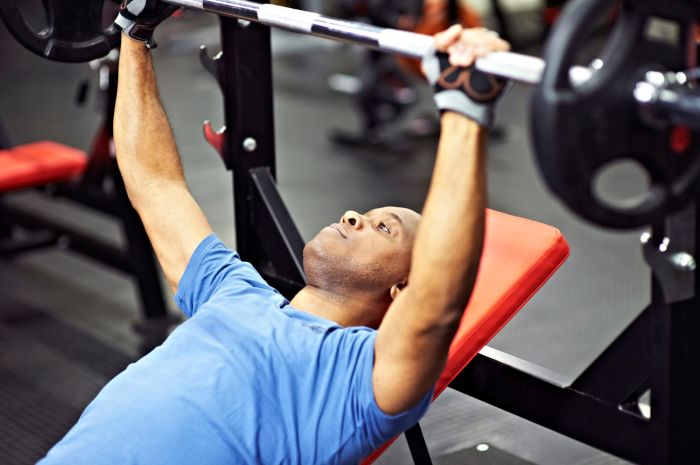Lifting weights for strength is an effective way to build muscle, increase power, and improve overall fitness. Whether you’re a beginner or an experienced lifter, this guide will provide you with the information you need to get started and achieve your strength goals.
In this guide, we’ll cover the basics of weightlifting for strength, including the benefits, how to choose the right weight, proper form, and sample workout plans. We’ll also discuss advanced techniques, nutrition, recovery, and safety considerations.
Introduction
Weightlifting, often referred to as strength training, is a form of exercise that involves lifting weights to develop muscular strength and power. It is a crucial component of any fitness regimen aimed at enhancing overall physical capabilities.
The fundamental principles of weightlifting for strength development revolve around progressive overload, specificity, and recovery. Progressive overload entails gradually increasing the weight, sets, or repetitions over time to continuously challenge the muscles and promote growth. Specificity refers to tailoring the exercises to target specific muscle groups or movements, while recovery involves allowing adequate rest periods for muscles to repair and rebuild.
– Weightlifting for Beginners
Starting a weightlifting routine can be daunting, but with the right approach, you can reap the benefits of increased strength, muscle mass, and overall fitness.
Choosing the Right Weight
Beginners should start with a weight that is challenging but allows them to maintain good form throughout the exercise. As a general rule, choose a weight that you can lift for 10-12 repetitions with good form.
Proper Form for Basic Exercises
Proper form is crucial to prevent injury and maximize results. Focus on maintaining a neutral spine, engaging your core, and using a full range of motion.
Sample Workout Plan
A simple workout plan for beginners might include exercises like:
- Squats
- Push-ups
- Rows
- Lunges
Types of Weightlifting Exercises
Weightlifting exercises can be categorized into various types based on several factors, including the muscle groups targeted, the equipment used, and the fitness level of the individual. Understanding these different types can help you tailor your workouts to meet your specific goals.
Exercises by Muscle Group Targeted
One way to classify weightlifting exercises is by the muscle groups they primarily target. Some of the major muscle groups and the exercises that target them include:
Chest
Bench press, dumbbell flyes, push-ups
Back
Deadlifts, pull-ups, rows
Legs
Squats, leg press, lunges
Shoulders
Overhead press, lateral raises, front raises
Arms
Bicep curls, tricep extensions, hammer curls
Exercises by Equipment Used
Another way to categorize weightlifting exercises is by the equipment used. Common types of equipment include:
Barbells
Used for exercises like squats, deadlifts, and bench press
Dumbbells
Used for exercises like bicep curls, tricep extensions, and lateral raises
Kettlebells
Used for exercises like swings and snatches
Machines
Used for exercises like leg press, chest press, and lat pulldowns
Exercises by Fitness Level
Weightlifting exercises can also be classified based on the fitness level of the individual performing them. Some exercises are suitable for beginners, while others are more appropriate for intermediate or advanced lifters.
Beginner exercises
Bodyweight squats, push-ups, dumbbell rows
Intermediate exercises
Barbell squats, deadlifts, overhead press
Advanced exercises
Olympic lifts, plyometrics, heavy compound exercises
Exercises by Goal
Finally, weightlifting exercises can be categorized based on the goal of the individual. Some exercises are designed for strength training, while others are better suited for hypertrophy (muscle growth) or endurance training.
Strength training exercises
Compound exercises, heavy weights, low repetitions
Hypertrophy training exercises
Isolation exercises, moderate weights, higher repetitions
Endurance training exercises
Bodyweight exercises, high repetitions, short rest periods
Progression and Periodization
Progression and periodization are crucial for weightlifting as they ensure gradual progress and prevent plateaus. Progression involves systematically increasing the weight, intensity, or volume of your workouts over time. Periodization divides your training into specific phases, each with its own focus and goals.
Training Phases, Lifting weights for strength
- Hypertrophy:Focuses on building muscle mass through high-volume, moderate-weight training.
- Strength:Aims to increase strength through heavy weight, low-volume training.
- Power:Combines strength and speed, using explosive movements with moderate weight.
Gradual Increase
Progress gradually by increasing weight or intensity by small increments. Avoid jumping to heavier weights too quickly, as this can lead to injury. Aim for a 5-10% increase in weight or intensity every 2-4 weeks.
Periodization
Periodization allows you to cycle through different training phases, each with its own goals. This prevents overtraining and ensures continuous progress. A typical periodization plan may include:
- Accumulation phase:Gradually increase volume and intensity to build a foundation.
- Intensification phase:Focus on heavy weight and low volume to maximize strength.
- Peaking phase:Fine-tune technique and taper off training before competition or testing.
Nutrition for Weightlifting
Proper nutrition is crucial for successful weightlifting. It provides the body with the necessary fuel and building blocks to support muscle growth, repair, and performance. This includes adequate calorie intake, sufficient protein, hydration, and optimal meal timing and frequency.
Calorie and Macronutrient Needs
Calorie needs vary depending on factors such as body weight, activity level, and training intensity. A general guideline is to consume 1.5-2.5 times your body weight in pounds. Macronutrient distribution should be approximately:
- Protein: 1.6-2.2g per kilogram of bodyweight
- Carbohydrates: 4-6g per kilogram of bodyweight
- Fat: 1-1.5g per kilogram of bodyweight
Importance of Protein Intake
Protein is essential for building and repairing muscle tissue. Aim for a daily intake of 1.6-2.2g of protein per kilogram of bodyweight. Good protein sources include lean meats, poultry, fish, eggs, dairy products, and legumes.
Hydration
Staying hydrated is crucial for overall health and performance. Aim to drink plenty of water throughout the day, especially before, during, and after workouts. Dehydration can impair muscle function and recovery.
Meal Timing and Frequency
Eating regular meals throughout the day helps maintain stable blood sugar levels and provides a steady supply of nutrients to the muscles. Aim for 3-4 meals per day, with snacks in between as needed.
Supplement Recommendations
While a balanced diet is essential, certain supplements can enhance performance. Consider incorporating the following:
- Creatine: Improves muscle strength and power
- Protein powder: Convenient way to supplement protein intake
- BCAAs: Essential amino acids that support muscle growth and recovery
Sample Meal Plan
Here’s a sample meal plan that meets the nutritional needs of weightlifters:
- Breakfast:Oatmeal with berries and nuts
- Lunch:Grilled chicken salad with brown rice
- Dinner:Salmon with roasted vegetables and quinoa
- Snacks:Protein shake, fruit, yogurt
Common Mistakes to Avoid
Avoid these common nutrition mistakes:
- Undereating:Not consuming enough calories to support training and recovery
- Insufficient protein intake:Not meeting the recommended protein needs for muscle growth
- Dehydration:Not drinking enough water to stay hydrated
- Skipping meals:Irregular eating patterns can disrupt nutrient delivery to the muscles
- Over-reliance on supplements:Supplements should complement a healthy diet, not replace it
Recovery and Rest: Lifting Weights For Strength
Proper recovery and rest are essential components of a successful weightlifting program. They allow your body to repair itself, rebuild muscle tissue, and prepare for future workouts.
There are several key aspects to consider when it comes to recovery and rest:
Adequate Sleep
Getting enough sleep is crucial for recovery. Aim for 7-9 hours of quality sleep each night. During sleep, your body releases hormones that promote muscle growth and repair.
Active Recovery Methods
Active recovery involves engaging in light physical activity on rest days. This can help improve blood flow, reduce muscle soreness, and promote flexibility.
- Go for a walk or jog.
- Do some light yoga or stretching.
- Swim or bike.
Stretching and Mobility
Stretching and mobility exercises can help improve your range of motion, reduce muscle tightness, and prevent injuries.
- Dynamic stretching before workouts.
- Static stretching after workouts.
- Foam rolling to release muscle tension.
Common Mistakes

Mistakes are inevitable during the weightlifting journey. These are some of the most common ones that can hinder progress and even lead to injury.
By being aware of these mistakes, you can take steps to avoid them and improve your weightlifting technique.
Lifting too heavy
- Using weights that are too heavy can lead to poor form, which can increase the risk of injury.
- It can also make it difficult to progress, as you will be unable to lift the weight with good form.
- Start with a weight that is challenging but allows you to maintain good form.
- As you get stronger, you can gradually increase the weight.
Poor form
- Poor form can lead to injury and can also limit your progress.
- It is important to learn the proper form for each exercise and to focus on maintaining good form throughout the entire set.
- If you are unsure about your form, ask a qualified personal trainer for help.
Overtraining
- Overtraining can lead to burnout, injury, and decreased performance.
- It is important to listen to your body and take rest days when needed.
- A good rule of thumb is to take one rest day for every two days of training.
Safety Considerations
When weightlifting, safety should always be a top priority. Taking proper precautions can help you prevent injuries and make your workouts more enjoyable.
Here are some important safety considerations to keep in mind:
Proper Warm-up and Cool-down
Warming up before lifting weights is essential to prepare your body for the workout. This can help reduce your risk of injuries and improve your performance. Start with light cardio and dynamic stretches, such as arm circles and leg swings.
Cooling down after your workout is just as important. This helps your body recover and reduces muscle soreness. Do some light cardio and static stretches, such as holding each stretch for 30 seconds.
Use of Spotters
A spotter is someone who assists you during your lifts, especially when you’re lifting heavy weights. They can help you lift the weight safely and prevent you from getting injured if you lose control.
Always use a spotter when lifting heavy weights or performing exercises that require you to lift the weight overhead.
Listen to Your Body
It’s important to listen to your body and rest when you need to. Don’t push yourself too hard, especially if you’re new to weightlifting.
If you experience any pain or discomfort, stop exercising and consult a medical professional.
Wear Appropriate Clothing and Footwear
Wear comfortable, breathable clothing that allows you to move freely. Avoid wearing loose clothing or jewelry that could get caught on the weights.
Wear supportive shoes with flat soles. Avoid wearing shoes with heels or slippery soles.
Exercise in a Well-lit and Ventilated Area
Exercise in a well-lit and ventilated area. This will help you stay alert and focused, and it will also help prevent you from overheating.
Avoid Exercising on Slippery or Uneven Surfaces
Avoid exercising on slippery or uneven surfaces. This can increase your risk of falling and getting injured.
Be Aware of Your Surroundings and Potential Hazards
Be aware of your surroundings and potential hazards. This includes other people, equipment, and obstacles.
Do Not Push Yourself Too Hard, Especially if You Are New to Exercise
If you’re new to weightlifting, don’t try to lift too much weight too soon. Start with a light weight and gradually increase the weight as you get stronger.
If You Experience Any Pain or Discomfort, Stop Exercising and Consult a Medical Professional
If you experience any pain or discomfort during your workout, stop exercising and consult a medical professional. This could be a sign of an injury.
Equipment

The right equipment is essential for effective weightlifting. Here’s an overview of the essential gear you’ll need:
Barbells, Dumbbells, and Weight Plates
Barbells, dumbbells, and weight plates are the foundation of any weightlifting setup. Barbells are long, straight bars that can be loaded with weight plates to create resistance. Dumbbells are shorter, handheld weights that allow for a wider range of exercises.
Weight plates come in various sizes and weights, enabling you to adjust the resistance to your needs.
Benches, Racks, and Machines
Benches, racks, and machines provide support and stability during exercises. Benches are used for exercises like bench press and dumbbell rows. Racks, such as power racks and squat racks, provide a safe and controlled environment for squats, bench press, and other exercises.
Machines, like cable machines and leg press machines, offer guided movements and adjustable resistance.
Accessories
Accessories can enhance your weightlifting experience and improve safety. Lifting belts provide support for your lower back during heavy lifts. Wrist wraps stabilize your wrists during exercises that put stress on them. Other accessories include knee sleeves, elbow sleeves, and lifting shoes.
Variations and Modifications

Weightlifting exercises can be tailored to suit different muscle groups, fitness levels, and equipment availability. Variations and modifications allow you to target specific areas, progress safely, and keep workouts challenging.
Exercises for Different Muscle Groups
- Upper body:Bench press, overhead press, pull-ups, rows
- Lower body:Squats, deadlifts, lunges, leg press
- Core:Planks, crunches, leg raises, Russian twists
Variations for Different Fitness Levels
Modify exercises based on your fitness level to avoid injury and ensure progress:
- Beginners:Start with bodyweight exercises or light weights with good form.
- Intermediate:Increase weight and resistance gradually, adding variations to target different muscle fibers.
- Advanced:Experiment with advanced techniques like drop sets, supersets, and periodization.
Use of Bands, Chains, and Other Equipment
Incorporate resistance bands, chains, and other equipment to enhance exercises:
- Bands:Add resistance throughout the range of motion.
- Chains:Increase resistance as the weight is lifted.
- Weightlifting belt:Support the lower back during heavy lifts.
Writing a Detailed Workout Plan
Create a workout plan that incorporates variations and modifications to maximize results:
- Warm-up:5-10 minutes of light cardio and dynamic stretching.
- Compound exercises:Focus on exercises that work multiple muscle groups.
- Isolation exercises:Target specific muscle groups for added definition.
- Rest:Allow adequate rest between sets and exercises to promote recovery.
- Progression:Gradually increase weight, sets, or reps over time to challenge your muscles.
Sample Workout Plan

Developing a workout plan is essential for effective weightlifting. Here’s a 4-week sample plan designed for beginners, providing a structured approach to building strength.
Week 1
Begin with 3 sets of 10-12 repetitions for each exercise, resting for 60-90 seconds between sets. Focus on proper form and technique throughout the workouts.
- Barbell squats: 3 sets of 10-12 repetitions
- Bench press: 3 sets of 10-12 repetitions
- Dumbbell rows: 3 sets of 10-12 repetitions per arm
- Overhead press: 3 sets of 10-12 repetitions
Week 2
Maintain the same exercises as in Week 1. Increase the weight slightly while keeping the sets, repetitions, and rest periods the same. This gradual progression challenges your muscles and promotes strength gains.
- Barbell squats: 3 sets of 10-12 repetitions
- Bench press: 3 sets of 10-12 repetitions
- Dumbbell rows: 3 sets of 10-12 repetitions per arm
- Overhead press: 3 sets of 10-12 repetitions
Week 3
Continue with the same exercises. Increase the weight again and reduce the repetitions to 8-10 per set. This higher intensity helps build strength and muscle mass.
- Barbell squats: 3 sets of 8-10 repetitions
- Bench press: 3 sets of 8-10 repetitions
- Dumbbell rows: 3 sets of 8-10 repetitions per arm
- Overhead press: 3 sets of 8-10 repetitions
Week 4
For the final week, maintain the weight from Week 3. Reduce the repetitions to 6-8 per set. This further intensifies the workouts, maximizing strength development.
- Barbell squats: 3 sets of 6-8 repetitions
- Bench press: 3 sets of 6-8 repetitions
- Dumbbell rows: 3 sets of 6-8 repetitions per arm
- Overhead press: 3 sets of 6-8 repetitions
Tracking Progress
Tracking your progress in weightlifting is crucial for staying motivated and making adjustments to your training plan. By monitoring key metrics, you can identify areas for improvement and ensure you’re progressing towards your goals.
Here are some essential metrics to track:
- Weight lifted: The amount of weight you lift during each exercise.
- Sets: The number of times you perform each exercise.
- Reps: The number of repetitions you perform within each set.
- Recovery time: The amount of time you rest between sets.
You can use a training log or app to record these metrics. Over time, you can track your progress and make adjustments as needed. For example, if you’re not seeing the desired results, you may need to increase the weight you’re lifting or the number of sets and reps you’re performing.
Visualizing your progress can be helpful. Consider using a spreadsheet or chart to plot your progress over time. This will help you identify trends and make informed decisions about your training.
Setting goals and tracking your progress towards them is also important. This will help you stay motivated and focused. Share your progress with a coach or training partner for accountability and support.
Advanced Techniques
Advanced techniques are training methods that can help you break through plateaus and continue progressing in your strength training journey. These techniques involve manipulating variables such as weight, sets, reps, and rest periods to provide an extra challenge and stimulate muscle growth.
Drop Sets
Drop sets involve performing a set of an exercise to failure, then immediately reducing the weight and continuing the set for as many reps as possible. This technique helps you push past your failure point and recruit more muscle fibers.
How to Perform Drop Sets:
- Choose a weight that is challenging but allows you to perform 8-12 reps.
- Perform the exercise to failure.
- Immediately reduce the weight by 20-25% and continue the set until failure.
- Repeat the drop set 2-3 times.
Examples of Exercises:* Barbell bench press
- Dumbbell squats
- Pull-ups
Supersets
Supersets involve performing two exercises back-to-back without rest. This technique helps you save time and increase intensity by targeting multiple muscle groups or opposing muscle groups. How to Perform Supersets:
- Choose two exercises that target different muscle groups or opposing muscle groups.
- Perform a set of the first exercise to failure.
- Immediately transition to the second exercise and perform a set to failure.
- Rest for 60-90 seconds and repeat the superset 2-3 times.
Examples of Exercises:* Barbell bench press and dumbbell rows
- Squats and leg press
- Bicep curls and tricep extensions
Forced Reps
Forced reps involve having a spotter assist you with the last few reps of a set when you reach failure. This technique helps you overcome sticking points and increase muscle mass. How to Perform Forced Reps:
- Choose a weight that is challenging but allows you to perform 8-12 reps.
- Perform the exercise to failure.
- Ask your spotter to assist you with the last 2-3 reps by providing just enough support to complete the set.
- Rest for 60-90 seconds and repeat the forced reps set 2-3 times.
Examples of Exercises:* Barbell squats
- Deadlifts
- Overhead press
Conclusion

Weightlifting for strength offers a multitude of benefits, including enhanced physical performance, improved body composition, and reduced risk of chronic diseases. To maximize these benefits, consistency in training is paramount, along with maintaining proper form to minimize the risk of injuries.
If you are new to weightlifting or have any underlying health conditions, it is advisable to seek guidance from a qualified professional to ensure safe and effective training.
As you progress in your weightlifting journey, remember to prioritize recovery and rest. Adequate sleep, nutrition, and hydration are crucial for muscle growth and repair. Listen to your body and take rest days when necessary to prevent burnout and overtraining.
By following these guidelines and embracing the principles of weightlifting, you can unlock your full potential and achieve your strength goals.
Closing Summary

Weightlifting for strength is a challenging but rewarding endeavor. By following the principles Artikeld in this guide, you can safely and effectively build muscle, increase strength, and improve your overall health and fitness.
Top FAQs
What are the benefits of weightlifting for strength?
Weightlifting for strength offers numerous benefits, including increased muscle mass and strength, improved bone density, reduced risk of injury, and enhanced athletic performance.
How do I choose the right weight?
When choosing a weight, it’s important to select a weight that is challenging but allows you to maintain good form. Start with a weight that is slightly lighter than what you think you can lift and gradually increase the weight as you get stronger.
What is proper form?
Proper form is essential for both safety and effectiveness. When lifting weights, always keep your back straight, engage your core, and use a full range of motion. Avoid using momentum or swinging the weight.
How often should I lift weights?
For optimal results, aim to lift weights for strength 2-3 times per week. Allow at least 48 hours of rest between workouts to allow your muscles to recover.
Leave a Reply